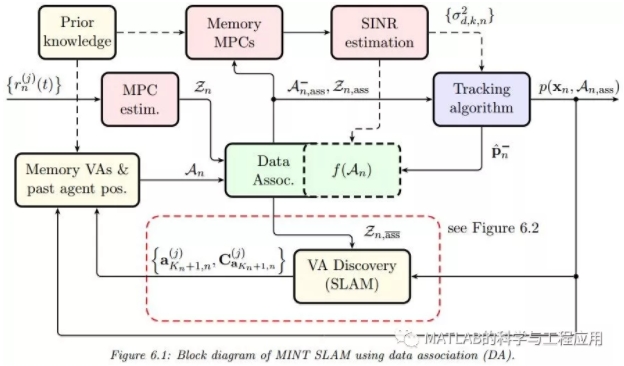
本文为奥地利格拉茨技术大学(作者:Dipl.-Ing. Erik Leitinger)的博士论文,共240页。
本论文提出一个鲁棒而精确的定位系统,将其行为与视觉大脑等周围环境相适应,模仿其过滤杂波的能力,并将研究集中在活动及相关信息上。尤其是在室内环境中,由于其多径传播的特点,在合理的基础设施需求约束下,要实现所需的准确度水平,仍然是一个难题。在这种环境中,必须将相关信息与无关信息分离,并为用于定位的测量建立适当的不确定度模型。
本论文的目标是通过在定位系统中实现人类认知的四个基本原则,即感知-动作循环(PAC)、记忆、注意力和智力,来更紧密地实现这一目标。为了满足所有这些原则,多径辅助室内导航和跟踪(MINT)的概念与Simon Haykin和合作者开发的认知动态系统(CDSs)的原理相交织。
MINT利用镜面多路径分量(MPC),这些分量可以使用已知的平面布置图与局部几何体关联。通过这种方式,MPC可以被视为来自其他虚拟源(称为虚拟锚(VAs))的信号,这些虚拟源是平面图中物理锚功能的镜像。因此,利用了无线电信号中包含的其他位置相关信息,该位置相关信息是基于几何的随机信道模型(GSCM)位置误差的克拉美罗下界(CRLB)量化的,以考虑几何相关MPC以及随机建模的漫射/密集多径(DM)。结果表明,信干噪比SINR能够量化位置相关信息的总量。
但是,本阶段不考虑平面布置图的不准确和VAs中由此产生的不确定性。因此,本论文引入了概率模型,旨在(i)消除精确已知的先验平面图的要求,以及(ii)应对环境表示中的不确定性。在概率MINT中,VAs是由一个基于几何的概率环境模型(GPEM)组成。在一个连续的步骤中,该算法被扩展到一种基于概率多径辅助特征的同时定位和映射(SLAM)方法,该方法可以在不了解平面图的情况下运行。
GSCM和GPEM表示开发的认知定位系统的内置记忆。与此相反,注意力是由算法本身执行的,通过实现相关和无关信息之间的分离,聚焦于存储的模型参数。通过基于认知控制器(CC)的传输波形自适应关闭PAC以支持这一分离过程,有助于(i)从周围环境中获取新的位置相关信息和(ii)抑制附加噪声。所有这些特征的相互作用是认知定位算法智能行为的关键推动者。
This thesis presents a robust and accurate positioning system that adapts its behavior to the surrounding environment like the visual brain, mimicking its capability of filtering out clutter and focusing attention on activity and relevant information. Especially in indoor environments, which are characterized by harsh multipath propagation, it is still elusive to achieve the needed level of accuracy robustly under the constraint of reasonable infrastructural needs. In such environments it is essential to separate relevant from irrelevant information and attain an appropriate uncertainty model for measurements that are used for positioning. The thesis has the goal to approach this objective more closely by implementing the four basic principles for human cognition, namely the perception-action cycle (PAC), memory, attention and intelligence, into the positioning systems. To encounter all these principles, the concepts of multipath-assisted indoor navigation and tracking (MINT) are intertwined with the principles of cognitive dynamic systems (CDSs) that were developed by Simon Haykin and co-workers. MINT exploits specular multipath components (MPCs) that can be associated to the local geometry using a known floor plan. In this way, MPCs can be seen as signals from additional virtual sources-so-called virtual anchors (VAs)-that are mirror-images of a physical anchor w.r.t. features of a floor plan. Hence additional position-related information is exploited that is contained in the radio signals. This position-related information is quantified based on the Cram′er Rao lower bound (CRLB) of the position error for a geometry-based stochastic channel model (GSCM) to account for geometry dependent MPCs as well as for stochastically modeled diffuse/dense multipath (DM). It shows that the signal-to-interference-plus-noise-ratio (SINR) quantifies the amount of position-related information. However, inaccuracies in the floor plan and the resulting uncertainties in the VAs, are not considered at this stage. Hence, probabilistic MINT is introduced in this thesis that has the aims (i) to remove the requirement of a precisely known a-priori floor plan and (ii) to cope with uncertainties in the environment representation. In probabilistic MINT the VAs are comprised in a geometry-based probabilistic environment model (GPEM). In a consecutive step, this algorithm is extended to a probabilistic multipath-assisted feature-based simultaneous localization and mapping (SLAM) approach that can operate without any prior knowledge of the floor plan. The GSCM and GPEM represent the built-in memory of the developed cognitive positioning system. In contrast, the attention is executed by the algorithm itself by enabling separation between relevant and irrelevant information and focusing onto the memorized model parameters. Closing the PAC with transmit waveform adaptation based on a cognitive controller (CC) supports this separation process and also facilitates (i) the feature of gaining new position-related information from the surrounding environment and (ii) suppression of additional noise. The interplay of all these characteristics is the key facilitator of intelligent behavior of the cognitive positioning algorithm.
1 引言
2 基于认知几何的随机环境模型
3 多径辅助定位的克拉美罗限CRLB
4 基于多径信道信息的定位
5 基于多径信道信息的位置跟踪
6 基于多径信道信息的同时定位与映射SLAM
7 基于多径信道信息的认知跟踪
8 结论
附录A CRLB的推导
附录B 多径仿真结果
附录C SINR的矩量估计方法研究
附录D 认知强化学习算法
下载英文原文地址:
http://page2.dfpan.com/fs/elc1j2d21f29e16d637/
更多精彩文章请关注微信号:
最后
以上就是美满保温杯最近收集整理的关于【电信学】【2015.11】用多径信道信息进行室内认知定位和跟踪的全部内容,更多相关【电信学】【2015内容请搜索靠谱客的其他文章。






![<信息论>[Matlab]-[实验二]离散信道的容量实验二 离散信道的容量](https://file2.kaopuke.com:8081/files_image/reation/bcimg14.png)

发表评论 取消回复